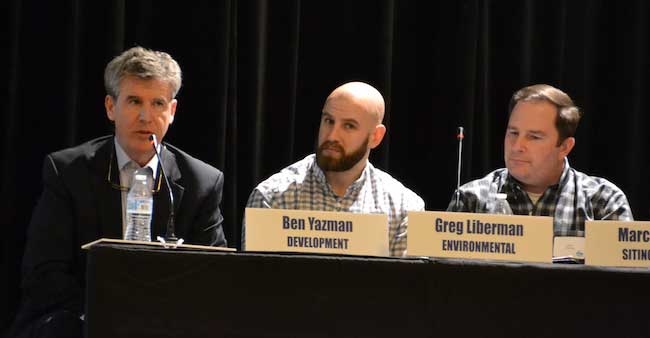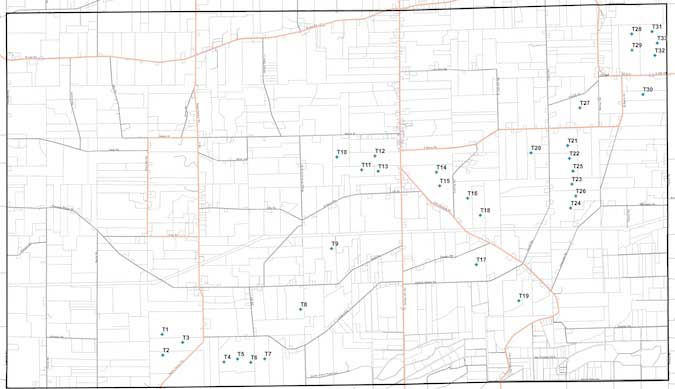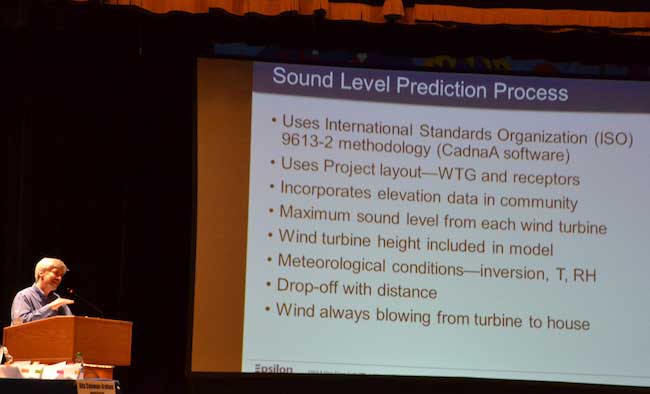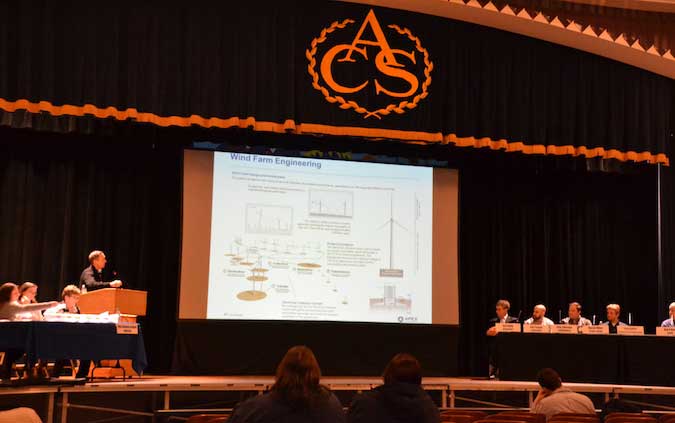Apex intends to apply in May-June to build 33 wind turbines in Barre
Company will propose turbines at 655 feet at highest tip height
ALBION – Apex Clean Energy intends to file an application with the state in May or June to build 33 wind turbines with a top tip height at 655 feet, making them some of the tallest structures in Western New York. (One Seneca Tower in downtown Buffalo is the tallest building in WNY at 529 feet.)
The turbines that Apex wants to build in Barre would each generate 4.8 megawatts of power or 158.4 MWs for the entire project. Apex had discussed for turbines with a 600-foot tip height for Barre that would have generated 4.2 MWs.
Getting taller turbines means they can produce more power. That also means the company won’t need to build as many. Apex was considering 47 turbines in Barre as part of Heritage Wind.

Neil Habig (left), is director of project development for Apex Clean Energy’s northeast renewable energy projects. He is joined on the panel by Ben Yaman (center), Heritage Wind project development manager; and Gregory Liberman, senior environmental project manager with Environmental Design & Research in Syracuse. He is working with Apex on many of the environmental studies.
The company held a community forum on Thursday evening at the Albion Middle School Auditorium and company officials discussed different aspects of the project for more than 2 hours. About 50 people attended the forum.
Apex would like to have the wind turbines operational in 2021, said Ben Yazman, project manager for Heritage Wind.
The project is expected to provide about $7,500 per MW to the community to offset taxes, about $1.2 million total. Lease holders also stand to receive at least $5,000 per MW, which would be about $800,000 at the minimum.
Yazman also said at least eight full-time jobs would be created with the project once construction is done.
Building the 33 turbines, running underground cables, constructing electric substations and all the other work on the project will top $200 million, said Neil Habig, director of project development for Apex Clean Energy’s northeast renewable energy projects.

Apex released this layout of the turbine locations, with most of the eastern side of town. Click on map to see it larger.
The company had a panel of experts available at the forum. They were asked many questions about the impact of the turbines on property values, shadow flicker, noise, town roads and wildlife.
Habig said numerous studies have shown turbines don’t depress property values. Because the turbines reduce town taxes, they often result in a community that is in more demand by residents, he said.
“The data shows no negative correlation,” he said. “It’s been studied extensively.”
New York is now home to about 25 wind projects, and Habig said they haven’t reduced property values in their communities.
The turbines will need a minimum wind speed of about 7 miles per hour to turn the blades and generate electricity. Habig said new technology and the taller heights allow the turbines to be financially feasible in areas that previously were thought to not have enough consistent and strong winds.
“The turbines blades are longer and don’t need as much wind to be viable,” he said.

Robert O’Neal, a managing principal at Epsilon Associates in Maynard, Mass., discussed sound impacts from turbines. He said the turbines won’t make enough noise to disrupt neighbors’ sleep.
Robert O’Neal, a sound expert for Apex, said the turbines won’t be louder than 45 decibels to the neighboring homes. That is below the threshold for when outside noise can affect a resident’s sleep, he said.
O’Neal said he has been involved with assessing noise at about 150 wind turbine projects. He said the low-frequency noise known as infrasound won’t be loud enough to cause headaches or affect health.
“Infrasound is in our homes,” he said. “It’s everywhere.”
Apex needs to provide detailed reports to the state as part of the application on many topics about health and safety, wildlife, a construction plan and other issues.
Marcel Minus is a senior energy analyst for Apex. He said shadow flicker is typically an issue for a few minutes each day, and only when it’s sunny outside. He focuses on wind flow modelling, layout design and energy production estimates for Apex. The taller turbines will produce longer shadows.
The company will be building access roads and will have to widen some town roads and increase turning radiuses. Apex will work with Barre town officials to make an assessment of the town roads before the project and then do an inventory of the condition after construction.
“We will leave them in the same or better condition that we found them,” Yazman said about the roads.

These Apex experts include Tracy Butler, construction; Robert O’Neal, sound; and James Muscato, a lawyer who focuses on the Article 10 application process through the state.
Apex also needs to have a decommissioning plan for the turbines. They are expected to last 25 to 30 years. The company needs to provide a financial security for the turbines’ removal as part of the decommissioning plan.
Tracy Butler, director of civil engineering for Apex, said the turbines would be taken down piece by piece. The top 4 feet of the concrete foundations would be jack-hammered out and soil would be put in. Access roads would also be removed and soil de-compacted so it could again be used for crops, if desired.
If Apex is sold, the project would transfer to the new owner. However, the Satte Siting Board would need to vote on transferring the project to the new owner. The same conditions for operating the project would apply to a new owner, said James Muscato, an attorney for Apex.
A video of the presentation will be available at Heritagewindpower.com. The company will also provide more answers to questions not answered at the meeting. Those answers will be on the Heritage Wind website and also posted to NYS Department of Public Service website that details correspondence and filings about the project in Barre.






































































